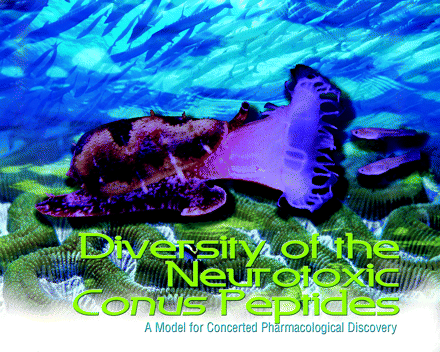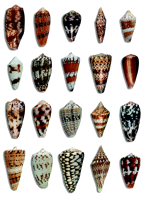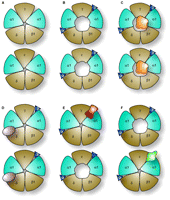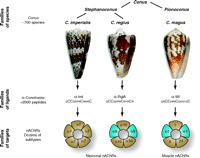Diversity of the Neurotoxic Conus Peptides
A Model for Concerted Pharmacological Discovery
Abstract
Predatory cone snails (genus Conus) produce a rich array of venoms that collectively contain an estimated 100,000 small, disulfide-rich peptides (i.e., conotoxins, or conopeptides). Over the last few decades, the conopeptides have revealed a remarkable diversity of pharmacological function and utility. An evolutionary rationale for the existence of such a large and pharmacologically diverse set of gene products can be premised on the complexity of intra- and interspecies interactions that define the ecology of Conus snails. Insights into these evolutionary trends, moreover, have been exploited with great neuropharmacological success, so that research into the Conus snails effectively recapitulates a new concerted discovery approach, which we discuss here, for developing unique ligands for both laboratory and therapeutic applications. The Conus peptides thus serve as a model system for reaping the pharmacological potential of biodiverse animal lineages.
Introduction
Most commercial drugs in the developed world are based on natural products (1), reflecting the complex arsenals of pharmacologically active compounds that organisms use to interact with each other. Research into the venoms of the predatory marine cone snails (genus Conus; Figure 1⇓) validates the great degree of pharmaceutical interest that rests on natural products. The small, disulfide-rich peptides that enrich Conus venoms (i.e., conotoxins, or conopeptides) have been shown to have considerable therapeutic potential and biomedical research utility (2–5). Nevertheless, from among the millions of species of animals available for natural product exploration, very few have made a contribution to the drug pipeline. Although the conopeptides may well be the most comprehensively characterized set of diverse pharmacologically active compounds from any species-rich lineage of animals, the cone snails, which comprise 500–700 species, may not be exceptional in the remarkable diversity of their pharmacological repertoire. It seems likely that other biodiverse animal lineages may have generated an equivalent pharmacological diversity, but the relevant compounds still await systematic, cross-species characterization. The continuing discovery work on Conus venom peptides, now spanning three decades, has resulted in an increasingly sophisticated interdisciplinary discovery platform that should be generally applicable to other biodiverse animal lineages. This platform allows investigators to coordinate the development of a great number of ligands, each with its own selectivity for members of large ion channel or receptor families and similar targets.
Shells of cone snails, the source ofConuspeptides. The shells shown are not to scale. From left to right, top row: C. geographus, geography cone; C. dusaveli, Dusavel’s cone; C. purpurascens, purple cone; C. milneedwardsi, glory-of-India cone; C. floridulus, blossom cone. Second row: C. varius, variable cone; C. cuvieri, Cuvier’s cone; C. generalis, general’s cone; C. imperialis, imperial ione; C. radiatus, radial cone. Third row: C. magus, magician’s cone; C. barthelemyi, Barthelemy’s cone; C. boschi, Bosch’s cone; C. delessertii, Delessert’s Cone; C. striatus, striated cone. Bottom row: C. monile, necklace cone; C. andamanensis, andaman cone; C. marmoreus, marble cone; C. praecellens, admirable cone; C. vitatus, vital cone.
Examples of potential target families, mostly found in nervous systems (see below), include nicotinic acetylcholine receptors (i.e., members of the Cys-loop receptor superfamily), Na+ channels (i.e., members of the voltage-gated ion channel superfamily), and NMDA receptors (i.e., members of the glutamate receptor superfamily). [For an overview of ion channel families, see (6, 7).] The development of ligands that are selective for the many receptor and channel subtypes that make up these protein families is an enormous challenge in pharmacology, promising great physiological advances and breakthrough therapeutics. The concerted analysis of ligands and targets that has defined Conus research over the years provides a systematic way to face this pharmacological challenge. The sets of peptides in Conus venoms (e.g., the ω-conotoxin family) have been arrayed over evolutionary time to selectively target certain isoforms of receptors and channels (e.g., a specific voltage-gated Ca2+ channel subtype). The general approach of concerted discovery, as exemplified by Conus research, requires that the animal lineage to be investigated should offer a significant level of pharmacological diversity. We discuss below why, during the radiation of any biodiverse lineage of animals (such as the cone snails), a pharmacologically diverse set of compounds would be expected to have evolved. The evolutionary rationale that underlies the unexpectedly rich pharmacological diversity found in cone snail venoms is a major theme of this review.
Conopeptide Families
Every Conus species appears to have a repertoire of 100–200 different venom components, most of which are the disulfide-rich conopeptides. Each Conus venom, moreover, has its own distinct complement of peptides, with essentially no molecular overlap between the venoms of different species. Thus, the 500–700 living Conus species have evolved 50,000 to 140,000 different conopeptides (2, 3, 5).
The diversity of the conopeptides is all the more intriguing because it is generated by a relatively small number of gene superfamilies expressed in Conus venom ducts (5). Conopeptide-encoding mRNAs consist of a single open reading frame that is translated into a canonical prepropeptide. The mature peptides in each gene superfamily generally have a characteristic arrangement of Cys residues. For example, the M superfamily of peptides, containing six highly conserved Cys residues and nineteen to twenty-five amino acids in all, include three disulfide linkages; the Cys pattern is accordingly indicated as CC–C–C–CC (Table 1⇓). In addition, the peptide precursors from a given gene superfamily share a strikingly conserved N-terminal signal sequence. In contrast, the mature peptide sequence is, with the exception of the conserved Cys residues, hypermutable (2, 5, 8, 9). Thus, like antibodies, conotoxin precursors exhibit a striking juxtaposition of highly conserved and hypervariable sequences.
Examples of Gene Superfamilies
The accelerated (i.e., hypermutable) molecular diversification of Conus peptide superfamilies continuously generates functional novelty, and peptides that are translated from a given gene superfamily, which are structurally related by definition, can consequently have completely different molecular targets. As shown in Table 1⇑, for example, all peptides in the O-conotoxin superfamily have the C–C–CC–C–C Cys pattern and are translated with conserved signal sequences; however, one group—the ω-conotoxins—are calcium channel blockers, whereas another group—the δ-conotoxins—inhibit the inactivation of sodium channels and therefore act to enhance Na+ channel conductance (5). Even when different members of a Conus peptide family have the same general target family, they will often diverge in molecular selectivity within the targeted family (see Table 2⇓). The α- and the ω-conotoxin families thus act on two distinct target families, namely, the nicotinic receptor family and the voltage-gated calcium channel family, respectively (5). For example, the α-conotoxin MI targets certain nicotinic receptors found in the neuromuscular postsynaptic junction (10, 11), whereas α-conotoxin RgIA targets an entirely different nicotinic receptor subtype expressed in neurons (12, 13). Similarly, the two ω-conotoxins shown in Table 2⇓ differ in their subtype selectivity for voltage-gated Ca2+ channels (5, 14). Thus, although there may be a general correlation of a Conus peptide family corresponding to a family of targets, individual members of the peptide ligand family diverge in their subtype selectivity for members of the target family. In effect, the conotoxin families that target particular ion channel or receptor families provide a rich source for concerted discovery and the development of multiple ligands, each with a characteristic pharmacological specificity (i.e., subtype specificity).
Concerted Evolution: Families of Conopeptides and Families of Targets
Pharmacological Diversity and Concerted Discovery: Understanding the Complexity ofConus Venoms
In the following sections, a rationale for the remarkable pharmacological diversity found in cone snail venoms is presented in a hierarchical fashion, progressing from molecules to more integrated and macroscopic levels. At all levels, the characterization of conopeptides has revealed that there are alternative ways to achieve any particular physiological end point. Through a consideration of this hierarchical organization, the power and broader applicability of methods from Conus research become clear.
The Hierarchy of Pharmacological Activities inConus Venoms
At the level of the individual molecular target, several alternative pharmacological sites may be envisioned through which a conotoxin might act. We shall take the nicotinic acetylcholine receptor (nAChR) as a specific example for the purposes of the present discussion. As a key component of neuronal signaling, pharmacological modulation of receptors or channels must additionally be considered within the context of circuit modulation. Cone snail venoms comprise multiple molecular components; thus, the neuromuscular nAChR is just one potential target in motor circuitry; voltage-gated Na+ channels and presynaptic Ca2+ channels are others. Furthermore, at the level of organismal targeting, several alternative circuits may exist (e.g., within prey organisms), and modulation of any one of these may achieve a similar physiological endpoint. For example, to immobilize its prey, a cone snail could impair motor circuitry or overexcite the peripheral axons that send signals to the central nervous system. Finally, at the ecosystem level, a spectrum of animals must typically be targeted by the cone snail venom, including prey, predators, and competitors. Survival of Conus species is predicated on venoms that act on the various relevant animals that characterize a given ecological niche. Thus, the pharmacological diversity of cone snail venom components is driven by evolutionary processes that must address: a variety of pharmacological sites on target molecules; the variety of molecular targets in each functional circuit; a multiplicity of circuits in a given targeted animal; and the diversity of target animals within the cone snail’s niche. All of these factors have contributed to the diversity in the pharmacological arsenals of the cone snails.
Molecular Targets
If one focuses on a single molecular target in a circuit, there are generally alternative strategies to perturb its function. This multiplicity of strategies is illustrated in the case of the nAChRs at the neuromuscular junction. Nicotinic acetylcholine receptors are heteropentameric complexes; in the vertebrate neuromuscular subtype, four different subunit isoforms comprise the functional receptor (15, 16) (Figure 2⇓). In mammalian systems, two subunits differ in the chronological order in which they are expressed; the γ-subunit is expressed first, until a few days after birth, when expression of the γ-subunit ceases and expression of the ε-subunit commences (16–18). However, in some vertebrates, such as fish, both γ- and ε-subunits are expressed into maturity (19). Thus, in some cases, fish-hunting cone snails may need to inhibit both receptor types to immobilize prey. For the purposes of our discussion, we will refer to the γ-bearing receptor subtype as the fetal form and the ε-bearing receptor subtype as the adult form, and we will use the two receptor subtypes as a simple model that could be extrapolated to even greater numbers of permutations among ligand–target interactions.
Alternative target sites of acetylcholine receptors (nAChRs). Each panel (A to F) shows two muscle nAChRs; the top receptor is the “fetal” subtype, with a γ subunit, and the bottom is the “adult” subtype, with an ε subunit. In the absence of acetylcholine (blue triangles) receptors are closed. When two molecules of acetylcholine bind (as shown in B), a transition from a closed to an open state occurs (compare A to B). Panels C, D, E, and F show effects of different conotoxins. Panel C demonstrates one possible mechanism of non-competitive block. In this example, the toxin (orange globular geometry) occludes ion conductance through the channel pore. Panels D, E, and F show competitive antagonists targeted to different pharmacological sites. In panel D, a conotoxin (purple) highly specific for α1δ is shown; this inhibits both fetal and adult subtypes. In E, a conotoxin (red) specific for the α1γ interface binds the fetal receptor, but not the adult subtype (which can therefore open normally). The converse is true in F, in which the conotoxin (green) is specific for α1ε; this does not inhibit the fetal subtype, but prevents acetylcholine from binding one of the two ligand sites in the adult subtype. Thus, to inhibit both receptors subtypes, either a single peptide with the specificity shown in D, or two different peptides with the specificities shown in E and F are required. In fish-hunting Conus venoms, there are usually two or more peptides targeting these muscle receptors; a venom with both the peptides shown in C and D would inhibit these receptors more efficiently than venoms with only one type of nAChR antagonist.
The fact that two molecules of acetylcholine must bind the nAChR in order to open the ion channel (20), with each molecule of agonist binding at different subunit interfaces, has resulted in challenges as well as opportunities for conopeptide-mediated modulation. On the one hand, the diversity of nAChR subunit isoforms (Figure 2⇑) offers opportunities for selectivity among conopeptide antagonists. On the other hand, conopeptide antagonists may be relatively non-selective, binding predominantly to the α1 subunit that is common to the receptor subtypes shown in Figure 2⇑. In terms of competitive antagonists of the fetal/adult pair of receptors described above, a conopeptide specific for the interface between the α1- and δ-subunits would inhibit both types of receptors, whereas a conopeptide specific for the α1-subunit–γsubunit interface would inhibit the fetal form of the receptor alone, and a conopeptide specific for the α1-subunit–ε-subunit interface would only inhibit the adult form. Finally, non-competitive sites may also be targeted. In this case, the antagonist might bind to the vestibule of the ligand-gated ion channel or to sites critical for coupling ligand binding to channel opening.
There is evidence that several of the alternative mechanisms of nAChR antagonism outlined above are actually used by different cone snails: 1) C. ermineus venoms contain nicotinic antagonists that bind to the α1-subunit–δ-subunit, α1-subunit–γ-subunit, and α1-subunit–ε-subunit interfaces [e.g., α-EI (21) and αA-EIVA (22)]. 2) The α1-subunit–δ-subunit interface is very selectively targeted by competitive conopeptide antagonists from the venoms of C. magus [i.e., α-MI (10, 11)] and C. parius [i.e., αC-PrXA (23)]. 3) In C. obscurus venom, nicotinic antagonists highly selective for the α1-subunit–γ-subunit interface [e.g., αA-OIVB (24)] have been identified. 4) In C. purpurascens venom and C. imperialis venom, both competitive and noncompetitive nicotinic antagonists are present: αA-PIVA (25) and ψ-PIIIE (26) from C. purpurascens; α-ImI and α-ImII (27) from C. imperialis.
Targeted Circuits
The complexity of neuronal circuits provides multiple points for perturbation by conopeptides. For example, to elicit vertebrate muscle contraction, the propagation of action potentials along a motor neuron axon requires the opening of voltage-gated Na+ channels. At the synaptic terminal, on the other hand, the action potential activates voltage-gated Ca2+ channels; the resulting influx of calcium, in turn, causing ACh to be released into the synaptic cleft. Activation of postsynaptic nAChRs depolarizes the motor end plate, thereby activating voltage-gated Na+ channels and ultimately leading to downstream signaling events that evoke muscle contraction [see (7) for an overview]. To paralyze its fish prey, a cone snail might thus utilize antagonists of Na+ channels, Ca2+channels, or nAChRs. Indeed, many Conus species utilize all three ligand types in combination for prey paralysis (2, 28, 29).
Typically, cone snails perturb any given circuit at several different points using multiple peptides, thus maximizing success in the execution of specific physiological goals; combinations of conopeptides that function together to elicit a given physiological response have been called cabals (2, 28, 29). Each component peptide in a cabal is pharmacologically distinct. The motor cabal (2), which inhibits muscle contraction, includes: ω-conotoxins, which target presynaptic Ca2+ channels and thereby inhibit neurotransmitter release; μ-conotoxins that inhibit the muscle action potential by blocking voltage-gated Na+ channels; and those peptides (discussed above) that differentially inhibit postsynaptic nAChRs to prevent depolarization at the motor end plate.
The Organism as Target: Perturbation of Multiple Circuits
Having considered some of the mechanisms of molecular and circuit targeting, we can now acknowledge that the targeted animal relies on multiple circuits for its survival, which brings us to the next level of hierarchy in the pharmacology of the conopeptides. For example, in addition to the motor cabal discussed above, certain fish-hunting cone snails also produce a cabal of peptides, known as the lightning strike cabal, to elicit immediate tetanic immobilization of prey (2). This cabal includes antagonists of voltage-gated K+ channels (e.g., κ-conotoxins) (29), peptides that delay inactivation of voltage-gated Na+ channels (e.g., δ-conotoxins) (29), and peptides that reduce the threshold for Na+ channel activation (e.g., ι-conotoxins) (30, 31). Thus, cone snails may utilize multiple toxin cabals to incapacitate prey. The evolution of diverse toxin cabals, each defined by the circuit that is targeted, and each consisting of an array of unique conopeptides specific for a corresponding array of respective molecular targets, offers ample opportunities for pharmacological investigation.
Multiple Biotic Interactions
Although its best known function is predatory, cone snail venom is also used for a broader set of biotic interactions (2, 8). Cone snails are prey to a broad spectrum of organisms, such as crabs, shell-breaking fish and rays, and drilling snails, and the defensive use of venom has been documented. Significantly, phylogenetically divergent species may contain physiologically analogous circuitry assembled from non-homologous molecular components. In contrast to the nAChRs that support neuromuscular transmission in vertebrates (Figure 2⇑), for example, a member of the non-NMDA glutamate receptor family is expressed for this purpose in arthropods (e.g., insects, arachnids, crustaceans) (32, 33). Conus venom components that target specific sensory circuitry in one type of predator may thus be ineffective against another type of predator, and molecular differences in circuitry across divergent prey, predators, and competitors bring yet another evolutionary dimension to conopeptide diversity.
Therapeutic Applications from Pharmacological Diversity
Apart from differences in the molecular components of circuitry discussed above, interspecies variation in the expression patterns of conserved proteins has proven to be therapeutically exploitable. Specifically, the fish-hunting magicians cone snail (C. magus) is the source of the ω-conotoxin MVIIA, which has been clinically developed into a drug for pain (Prialt®) (34–36). This conotoxin, a component of the motor cabal, targets the N-type calcium channel (CaV2.2) that is expressed in the motor neurons of fish prey, thereby providing a mechanism for paralysis. In mammals, the CaV2.2 subtype is expressed predominantly in the central nervous system, and the conopeptide is consequently not paralytic to humans; rather, it has potent analgesic effects when administered to the spinal cord. Other clinical applications of conopeptides are summarized in Table 3⇓. One remarkable feature is the plethora of molecular targets uncovered for a single clinical problem, namely, pain. Six different types of molecular targets—none of them opioid-based—have been validated by the discovery of Conus peptides. There seems little doubt that as the pace of discovery increases, the number of new clinical applications of Conus peptides should increase in parallel.
Therapeutic Applications of Conopeptides
Approach to Pharmacological Discovery
The characterization of a minor cross section of all Conus venom peptides provides insights for an approach to pharmacological discovery with great potential. This approach crucially depends on certain disciplines, discussed in the following sections, that have not been significantly utilized in conventional drug discovery
Anatomy
A key feature of animals is their highly differentiated tissues; specialized biochemistry not required for general metabolism is invariably carried out in specific tissues or glands. For the discovery work on cone snail venom peptides, dissection of the often tiny venom ducts has been indispensable. The standard (bio-prospecting) approach of analyzing whole-body extracts would have precluded the identification of conopeptides. The general neglect of the relevant animal anatomy may thus explain one reason for the lack of lead development from animal biodiversity. Careful anatomical evaluation of animal lineages under investigation, with a focused analysis of appropriate specialized tissues, may often be essential.
Molecular Genetics
Even when confronting the biochemically rich Conus venom ducts as a starting point for pharmacological discovery, the amount of starting material can be problematic, and early conopeptide research in particular was limited to larger and more common Conus species. However, the characterization of the gene families that encode pharmacologically active peptides has dramatically changed the discovery landscape, so that discovery can now be extended to virtually any Conus species that can be obtained alive. Bouchet and coworkers have shown that most deep-water venomous marine mollusks (such as the turrids) are under 3mm in length and thus rarely collected (37). Such animals would be completely inaccessible if standard protocols for pharmacological discovery were used. The characterization of the rapidly diversifying superfamilies of conopeptide-encoding genes, especially through PCR techonology, has had a major impact on discovery.
Phylogeny
The characterization of gene superfamilies allows investigators to scan numerous sequences before committing to the more arduous labor of expressing or synthesizing a particular peptide. Determination of the phylogenetic relationships among cone snail species provides important guidelines for research. In general, peptides made by closely related species are more likely to be similar, both structurally and functionally. Thus, to obtain a series of related peptides for analysis of structure-activity relationships relative to a given molecular target, phylogenetic data can determine which species should be scanned. If the goal, for example, is to find ligands selective for significantly differing target subtypes, then species that are correspondingly distinct in their phylogenetic relationship should be investigated.
Overview and Conclusion
Conopeptide research provides the model of a discovery platform that exploits concepts from ecosystem biology and that should be broadly applicable in terms of animal resources. Gene products that mediate interactions between organisms (i.e., pharmacologically active products that have targets exogenous to the organism of origin) are encoded by exogenes, a term originally used to rationalize conotoxin gene hypermutation (3). Exogene families, such as those that encode the conopeptides, are expected to be extremely rapidly diversifying. It has been suggested that there may be special genetic mechanisms acting on the conopeptide-encoding exogenes to generate the characteristic juxtaposition of highly conserved and hypervariable regions. An example of a biodiverse animal lineage, distinct from Conus, where this approach should be directly applicable are the thousands of species of parasitic wasps that inject their exogene products into insect hosts (38, 39). As in Conus, we expect the products of exogene families to diverge among each species of wasp, thereby generating the pharmacological diversity required for concerted discovery. Like Conus, these wasps also have specialized mechanisms for delivery of exogene products to affect the organisms with which they interact.
Animals that do not have specialized injection mechanisms often use gene products that are processed into non-peptidic organic molecules to interact in their ecosystems. These can pass membrane barriers (such as between the gut and the circulation, or the blood/brain barrier), and in principle, provide the most desirable of drug leads. The study of ascidian compounds, which are likely exogene products (i.e., peptidic translation products that are converted into non-peptidic compounds) and used by these sessile marine animals to defend themselves, has shown that the general principle of rapidly diversifying exogene families applies to this otherwise completely dissimilar biological system.
The exogene cluster that encodes the patellamides, a family of diverse natural products previously identified from several species of ascidians has been characterized (40, 41). The patellamides, are ultimately derived from single small peptides that undergo enzyme-catalyzed reactions, including heterocyclizing mechanisms, to produce the final patellamide structure. Surprisingly, the ascidian genome does not give rise to these compounds; rather, the exogenes that provide the gene products that are converted into the patellamides are found in genomes of the obligate Prochloron cyanobacterial symbionts of the studied ascidians. It remains an open issue to what extent other lineages of animals rely on bacterial symbionts to produce pharmacologically active compounds for their biotic interactions. From the evolutionary point of view, the reliance of animal species upon symbiotic bacteria to mediate interactions outside of the symbiotic relationship may be a widely used option, because the symbiotic bacteria, with their short generation time, can evolve much faster than can the genome of the animal host and thereby produce novel chemicals.
In essence, such natural products have evolved through co-selection on host and symbionts. The Prochloron operon, which is an exogene cluster, encodes the enzymes necessary to convert one of the direct translation products of the exogene cluster (a small peptide) into the final biologically active non-peptidic compound. When different ascidians that produce the different patellamides are compared, the operon sequences are virtually identical except for regions of one gene that encode the small peptidic precursors. Thus, compared to Conus peptide genes, patellamide-encoding operons have a much higher proportion of highly conserved sequence, but these are juxtaposed with the small hypervariable peptide-encoding cassettes. The entire operon has been heterologously expressed in E. coli to produce the patellamide in an E. coli culture medium. Whether pharmacologically active compounds produced by an animal lineage are peptidic or non-peptidic, and regardless of the genomic/metagenomic organization of the relevant genes, the discovery platform described above should be applicable. The essence of the approach is that the discovery process will in large part involve the multidisciplinary analysis and characterization of exogenes, followed by the development and pharmacological characterization of selected gene products.
Finally, it should be emphasized that the advantage of a discovery initiative using an entire lineage of animals is not just that an enormous diversity of pharmacologically active compounds can be accessed, but that the discovery and development of these compounds is concerted, that is, multiple ligands targeting the same family of targets (such as nAChRs or Ca2+ channels) can be developed at the same time (Figure 3⇓). The salient advantage of starting with a family of related animal species is that the same exogene families are probably expressed widely throughout the given lineage. This wide distribution of homologous exogene products (as opposed to the diversity per se) results in the targeting of multiple supbtypes of a particular family of receptors or ion channels, so that we can attain potential examples of each specific ligand having a different subtype selectivity. Thus, in the example given in Figure 3⇓, all of the peptides target nAChRs, but each individual peptide selectively targets a different nAChR subtype. The concerted discovery and development of subtype-specific ligands for multiple members of the nAChR family was made possible by using the cone snail lineage. This is a powerful pharmacological approach, because developing subtype-selective ligands allows the differentiation of closely related target isoforms, thereby making it possible to sharply delineate their physiological functions.
A strategy for concerted discovery of ligand–target interactions and development. The figure provides a simplified overview of a single case study of concerted discovery. Representative species of cone snails are shown from two different subgeneric groups (clades): the worm-hunting Stephanoconus clade and the fish-hunting Pionoconus clade. From these and other Conus species, members of the α-conotoxin family, which generally target nicotinic acetylcholine receptors, were characterized. Different α-conotoxins are found in each species shown; however, the α-conotoxins from the closely related C. imperialis and C. regius (α-ImI and α-RgIA, respectively) are more similar to each other than the α-conotoxin from the distantly related C. magus (α-MI). α-ImI and α-RgIA also target closely related neuronal nAChRs; α7–α10 neuronal nAChRs are believed to form primarily homomeric pentamers. In contrast, α-MI targets the heteromeric nAChR expressed in muscle. The general concept of concerted discovery is that related species of animals produce related (but non-identical) ligands with specificity for related (but non-identical) targets.
Acknowledgments
The work of the authors has been supported by Program Project GM48677 from the National Institute of General Medical Sciences. We thank Jason Biggs for the image of C. tulipa on the title page of this article.
- © American Society for Pharmacology and Experimental Theraputics 2007
References

Russell Teichert, PhD, received his BA and MBA degrees from Brigham Young University. He completed his doctoral work in 2005 at the University of Utah with Baldomero Olivera. He is currently Research Assistant Professor in the Biology Department at the University of Utah, where he continues to elucidate the biochemistry and neuropharmacology of Conus peptides. E-mail teichert{at}biology.utah.edu.

Baldomero (Toto) Olivera, PhD, studied chemistry at the University of the Philippines and earned his doctorate from Caltech. As a postdoctoral fellow at Stanford University, he discovered and characterized E. coli DNA ligase, and thereafter began to investigate peptide toxins from Conus snails. He is now Distinguished Professor of Biology at the University of Utah. His research into conopeptides has yielded important tools for understanding ion channel and receptor function in nervous systems. Several cone snail peptides discovered in his lab have therapeutic applications, particularly for alleviating pain, and one of these has been developed into an approved drug. E-mail olivera{at}biology.utah.edu, fax 801-585-5010.







